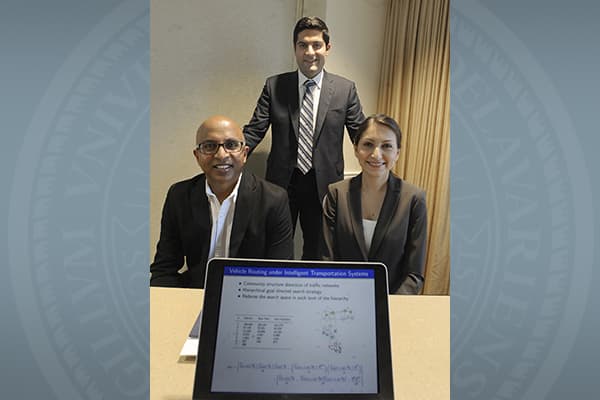New Technique For Data Reduction To Help Enhance Intelligent Transport Systems
A group of engineers from the University of Delaware has innovated a reduced traffic dynamics data system that might help to boost the Intelligent Transportation System (ITS) . ITS is a 21st century technology, integrated with the GPS of electronic devices that predicts the suitable traffic choice.
Lena Mashayekhy, assistant professor of computer science at the University of Delaware and co-researcher, explained that these systems sometimes fail to give real time information due to a stream of connected data. To counter such a delay, the team designed an efficient way to reduce the data and made it available for use in ITS.

Ratna Babu Chinnam, Mark Nejad and Lena Mashayekhy displaying their work
The traffic dynamics, such as vehicle speed, the number of vehicles, and the location of accidents constitute huge amount of information. Named as HTGD (hierarchical time-dependent goal directed), the method relies on the proprietary search algorithm. In this approach, it first sorts out similar “communities†and finds out the shortest route to the destination, leaving out unnecessary communities that do not fall on the optimal path.
Mashayekhy expressed that their computational model sports a balanced approach when compared to other contemporary vehicle routing navigation systems. The latest method has already been applied to Detroit, New York, and San Francisco road networks and the results efficiently match with their theoretical predictions. The research report was published in the February issue of the IIE Transactions.
Source: #-Link-Snipped-#
Lena Mashayekhy, assistant professor of computer science at the University of Delaware and co-researcher, explained that these systems sometimes fail to give real time information due to a stream of connected data. To counter such a delay, the team designed an efficient way to reduce the data and made it available for use in ITS.

Ratna Babu Chinnam, Mark Nejad and Lena Mashayekhy displaying their work
Mashayekhy expressed that their computational model sports a balanced approach when compared to other contemporary vehicle routing navigation systems. The latest method has already been applied to Detroit, New York, and San Francisco road networks and the results efficiently match with their theoretical predictions. The research report was published in the February issue of the IIE Transactions.
Source: #-Link-Snipped-#
0
